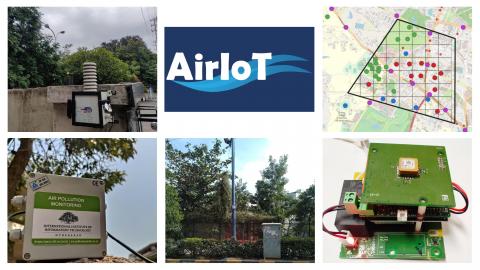Datasets
Open Access
AirIoT: IoT-Based Air Pollution Monitoring
- Citation Author(s):
- Submitted by:
- Ayush Dwivedi
- Last updated:
- Tue, 01/07/2025 - 08:47
- DOI:
- 10.21227/b9g8-wc47
- Data Format:
- Link to Paper:
- Links:
- License:
 1449 Views
1449 Views- Categories:
- Keywords:
Abstract
AirIoT is a temporal dataset of air pollution concentration values measured for almost three years in Hyderabad, India. In AirIoT, a dense network of IoT-based PM monitoring devices equipped with low-cost sensors was deployed. The research focuses on two primary aspects: measurement and modelling. The team developed, calibrated, and deployed 50 IoT-based PM monitoring devices throughout Hyderabad, India, covering urban, semi-urban, and green areas. The team also developed a web-based spatial data dashboard and an Android app to dynamically visualize data from the IoT network, providing actionable insights for citizens and government bodies to effectively control pollution. Spatial interpolation models were designed to extrapolate measurements at both micro and macro levels. The effectiveness of this dense deployment was demonstrated through a case study during the Diwali festival, highlighting the need for localized data in areas with significant air pollution hotspots.
Additionally, the project explored the health impacts of air pollution, correlating the data with respiratory, cardiovascular, and psycho-physiological effects. A pilot study leveraging data from AirIoT, health wearables, and a questionnaire was conducted to investigate the long-term health implications for security personnel exposed to air pollution. The team also developed computer vision-based methods to scale air pollution monitoring by analyzing features such as visibility, traffic type, and density, reducing the reliance on frequent sensor usage. These methods, trained on a large dataset using deep learning, predict air quality in real time, providing a viable solution for large-scale implementations.
To ensure citizen engagement and capacity building, pilot studies were conducted in schools, involving students in the understanding and mitigation of air pollution. Public display systems showcasing real-time pollution levels fostered excitement and awareness, leading to community advocacy for reforms. Engineering students from various colleges were engaged through hackathons and internship programs to develop low-cost air pollution monitoring devices for local measurements at their institutions and neighbourhoods. The work focuses on air quality monitoring and integrates with broader smart city applications through the Smart City Research Center at IIITH. This collaborative initiative, blending IoT technology with social participation, offers a comprehensive, data-driven approach to tackle the complex challenges of air pollution in India.
This is the raw dataset of uncalibrated concentration values as sensed by the sensors. The dataset contains 50 CSV files, each corresponding to a location at which the sensors were deployed. The following are the details about the sensor values:
For 01.CSV to 11.CSV
- created_at: Time of sensor reading (yyyy-MM-dd'T'HH:mm:ssXXX","TimeZone","Asia/Calcutta")
- entry_id: A unique ID associated with every sensing instance
- field1: Temperature (in deg celcius)
- field2: Relative humidity (in %)
- field3: PM2.5 (in ppm)
- field4: PM10 (in ppm)
For 12.CSV to 50.CSV
- created_at: Time of sensor reading (yyyy-MM-dd'T'HH:mm:ssXXX","TimeZone","Asia/Calcutta")
- entry_id: A unique ID associated with every sensing instance
- field1: PM10 (in ppm)
- field2: PM2.5 (in ppm)
- field3: Relative humidity (in %)
- field4: Temperature (in deg celcius)
All other fields in the dataset were for research purposes only and can be discarded.
Dataset Files
LOGIN TO ACCESS DATASET FILESOpen Access dataset files are accessible to all logged in users. Don't have a login? Create a free IEEE account. IEEE Membership is not required.
Documentation
| Attachment | Size |
|---|---|
| 870 bytes |






